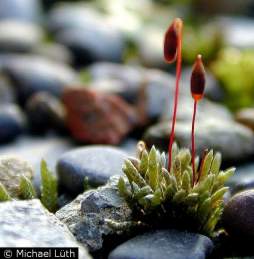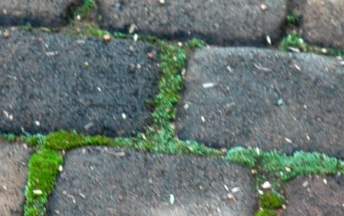Bryum argenteum
Bryum argenteum Hedw.
Family: Bryaceae
Common names: silver moss, silvery threads moss
Introduction
Bryum argenteum is one of the most cosmopolitan mosses found throughout South Africa. It is most easily recognized by its whitish or silvery green leaves. It is widespread in driveways, on sidewalks and in back yards.

Description
Description
Bryum argenteum is a bryophyte (moss) that forms very close tufts or cushions; it occurs in patches or is found as scattered individuals mixed with other mosses. Plants are small to medium - sized, 1 - 25 mm long. The stems are julaceous (smoothly cylindrical, like a catkin), 1-25 mm tall, yellowish green or red to red-brown, and branched below. The leaves are crowded and tightly held to the stem, overlapping each other, broadly ovate and concave and green below. The upper surface is hyaline (transparent), usually with a tapering, short point. The sporophytes consist of yellow to reddish brown, short, arched setae, 7-20 mm long and red-brown capsules, 1 - 2 mm long, drooping and wrinkled when dry. The spores are 10 - 15 µm in diameter and finely papillose. The plant is perennial.

Conservation Status
Status
None.
Distribution and habitat
Distribution description
The silver moss is one of the most cosmopolitan mosses and is found throughout South Africa, commonly in human settlements. It is prevalent in atmospherically polluted areas e.g. in big cities on tarred roads, on concrete structures (e.g. between paving stones, at the bases of walls, on roofs and windowsills), on soil as well as in waste areas.

Derivation of name and historical aspects
History
The species epithet argenteum refers to the characteristic silvery colour of the plant. The genus Bryum is the largest genus of the family Bryaceae. In sub-Saharan Africa it consists of about 93 species.
Ecology
Ecology
Tan & Pócs (2000) mention Bryum argenteum among the mosses that have adapted to, and are more dominant in man-made habitats than in their natural habitat.
Uses
Use
No uses have been documented for Bryum argenteum in South Africa. However, overseas it is reported to be of value in pollution monitoring and control. This is due to its ability to tolerate drought and pollution of urban environments. It is also frequently used for experimental approaches to evolutionary processes.
Growing Bryum argenteum
Grow
Although it seems to grow widely, it is not cultivated and is reported to have failed in flower pots of soil (Fletcher 1991).
References
- Fletcher, M. 1991. Moss grower's handbook : 31. Seventy Press, Berkshire.
- Magill, R.E. 1987. Bryophyta. Flora of southern Africa, part 1, fasc. 2: 361 - 366.
- Richardson, D.H.S. 1981. The biology of mosses : 152. Blackwell Scientific Publications, Oxford.
- Tan, B.C. & Pócs, T. 2000. Biogeography and conservation of bryophytes. In A. Jonathan Shaw & B. Goffinet, Bryophyte biology : 405. Cambridge University Press, United Kingdom.
Credits
Nonkululo Phephu
National Herbarium, Pretoria
May 2008
Plant Attributes:
Plant Type: Moss
SA Distribution: Eastern Cape, Free State, Gauteng, KwaZulu-Natal, Limpopo, Mpumalanga, North West, Northern Cape, Western Cape
Soil type: Sandy
Flowering season:
PH: Neutral
Flower colour:
Aspect: Full Sun, Shade, Morning Sun (Semi Shade), Afternoon Sun (Semi Shade)
Gardening skill: Challenging
Special Features:
Horticultural zones











Rate this article
Article well written and informative
Rate this plant
Is this an interesting plant?
Login to add your Comment
Back to topNot registered yet? Click here to register.